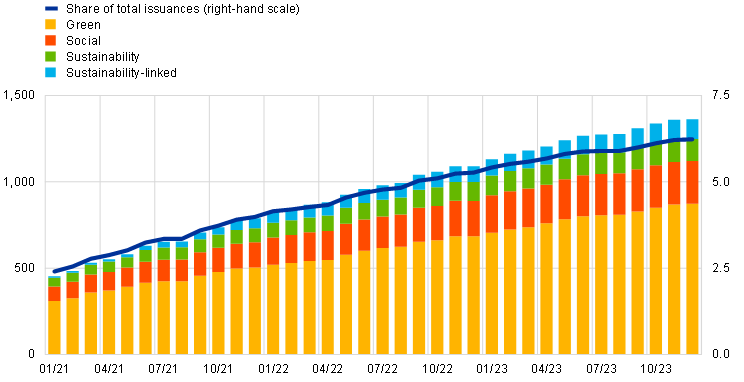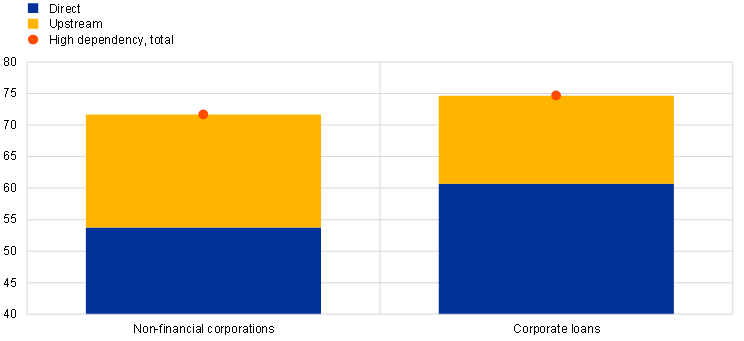Published as part of the ECB Economic Bulletin, Issue 2/2024.
On 30 January 2024 the ECB published its climate and nature plan 2024-2025, which identifies three new focus areas that will guide its climate actions over the next two years. This box explains the economic reasoning behind the ECB’s decision to advance its work in these three areas.[1]
Climate change is increasingly affecting the euro area economy. The world is way off-track in terms of meeting the climate targets consistent with the 2015 Paris Agreement.[2] 2023 was the warmest year ever recorded, and several extreme weather events caused economic damage in Europe and across the world. In parallel, accelerated biodiversity loss and degradation of habitats are contributing to a rapidly evolving crisis for nature, partially owing to the inextricable links between climate and nature. Climate change and the related need to foster the green transition are increasingly affecting the economy and the financial system. This may have implications for price stability, financial stability and the transmission of monetary policy. Climate change also affects the value and risk profile of assets on the Eurosystem balance sheet. It is essential for the ECB to account for these effects in order to deliver on its primary objective of price stability.
Since 2021 the ECB has broadened its commitment to integrating climate change considerations into its activities. Following the review of its monetary policy strategy, in 2021 the ECB announced its first climate action plan, in which it committed to including climate change considerations in activities related to monetary policy implementation, macroeconomic analysis and statistics.[3] In 2022 the scope of the plan was expanded to cover climate activities in other areas of the bank’s activities, including financial stability and banking supervision.[4] After completing an in-depth stock-take of its climate actions, in January 2024 the ECB published an updated plan for the period 2024-2025. For the first time, this plan includes the commitment to analyse nature-related issues. It identifies three focus areas that will guide the ECB’s climate-related activities for the next two years (Table A).
Table A
Focus areas for the ECB’s climate and nature plan 2024-2025
Three focus areas | What we will do | |
|---|---|---|
| 1. Navigating the transition towards a green economy | • Assess green investment needs and their funding. • Analyse the structural consequences stemming from the transition. • Analyse the effects of transition funding and transition risks on the monetary policy transmission mechanism. • Advance the macroeconomic modelling framework with a focus on climate aspects. |
| 2. Addressing the increasing physical impact of climate change | • Take further steps to integrate climate change impacts into climate scenarios and the analytical framework used for macroeconomic projections. • Explore the impact of climate adaptation, including the insurance protection gap. • Improve the availability of data to support physical risk analysis. |
3. Advancing work on nature-related risks | • Further explore the economic and financial implications of biodiversity loss and the degradation of nature. | |
The first focus area looks at the challenges involved in navigating the transition towards a green economy. To comply with its 2050 net zero target, Europe will need to implement dedicated policy measures until 2030 to incentivise a shift towards energy-efficient production processes and consumption patterns, and to replace fossil fuels with renewable energy sources.[5] This will result in profound structural changes to the euro area economy, with implications for employment and skill requirements. It may cause a reallocation of capital with ambiguous long-run effects on potential growth.[6] The green transition will have an impact on trade and capital flows in the euro area economy and pose risks to its external competitiveness. The euro area may also become more vulnerable to supply chain risks and interruptions to the supply of critical minerals needed for the transition. It is important for the ECB to have a thorough understanding of these structural changes and challenges, and how they could impact the macroeconomic outlook for the euro area. To do so, macroeconomic models need to be adapted accordingly.
Green investment, technological innovation and green funding are key to moving towards a low-carbon economy. The estimates by various institutions of how much green investment is needed to achieve climate goals vary widely. For instance, according to the European Commission, the transition will require additional annual investment of €620 billion until 2030 for the EU to reach its 55% emission reduction target.[7] The ECB will take a closer look at the different estimates available to better understand the underlying assumptions and driving factors, including the role of climate change policies. It will look at the framework conditions required to facilitate the necessary investments, including the need to foster an environment conducive to high levels of research and development and innovation capacity, and a market infrastructure that encourages risk-taking. Close attention will be paid to the funding side of green investment needs. Although there has been strong growth in green finance instruments in recent years, they still only account for a small share of total debt securities issued in the euro area (Chart A). Specifically, the ECB will analyse whether the supply of funding is meeting demand, what lending conditions firms are facing for green investment projects, and how public policies can help mobilise more private funding, including through better disclosure requirements. These are all relevant issues for monetary policy and its transmission mechanism.
Chart A
Euro area issuance of sustainable debt securities
(left-hand scale: EUR billions, outstanding amounts at face value; right-hand scale: percentages of total euro area-issued debt securities)

Sources: Centralised Securities Database and ECB calculations.
Notes: The chart shows euro area issuance of environmental, social and governance debt securities for all levels of assurance. The “Share of total issuance” refers to the amount of all sustainable securities as a share of all debt securities issued in the euro area.
The second focus area aims to address the increasing physical impact of climate change. Extreme weather events are becoming more frequent and their costs increasingly clear.[8] Together with changes in weather patterns, they affect the macroeconomy and financial sector through various channels. Changes to the climate particularly affect the agriculture, tourism and, via food prices, the retail and restaurant sectors. After the heatwave of summer 2022, food price inflation in Europe is estimated to have risen by 0.67 percentage points a year later.[9] Increased global heating is found to have non-linear effects on food prices, posing risks to heightened inflation dynamics going forward. Empirical analyses find that increases in temperature above certain thresholds reduce labour productivity and economic growth.[10] It is essential for the ECB to enhance its assessment of how a changing climate affects inflation and the economy. Besides access to high-quality data, this will require further exploration of how to integrate the physical impacts of climate change into climate scenarios and the analytical framework used for the macroeconomic projections.
Adaptation finance will be a major area of new research. The costs associated with the physical impact of climate change pose financial and fiscal risks, yet only a quarter of climate-related catastrophic losses are insured.[11] However, adaptation investment to limit exposure to physical climate risks will divert resources away from more productive investment opportunities.[12] The ECB will explore the economic and financial implications of climate adaptation measures and the associated funding needs required to make the economy more resilient to a changing climate.
The third focus area explores nature-related risks. There is growing evidence that climate change has adverse implications for nature, while the degradation of nature in the form of intensive land use, pollution and overexploitation of resources amplifies the climate crisis. Degradation of nature leads to reduced capacity for carbon uptake and storage and lowers the resilience of soil to the impacts of extreme weather events and a changing climate. In Europe, more than 80% of habitats are already in poor condition.[13] Nature loss poses a serious risk to humanity, as it threatens vital functions, such as the supply of food and medicines.
Degradation of nature affects the economy and leads to financial risks. According to the survey on the access to finance of enterprises (SAFE), 48% of euro area firms are very concerned about the implications of environmental degradation for their business.[14] This is in line with recent research finding that 72% of euro area non-financial corporations are strongly dependent on at least one ecosystem service, such as healthy soils, clean water and protection against floods. As these firms account for 75% of the corporate loan exposures of euro area banks, nature-related risks pose a clear risk to banks (Chart B). The ECB will study the implications of nature and biodiversity loss for the economy, their interplay with climate change and how they can affect macroeconomic variables relevant for its mandate.
Chart B
Dependencies of euro area non-financial corporations and loan portfolios on ecosystem services
(percentages)

Sources: ENCORE, EXIOBASE, AnaCredit and ECB calculations.
Notes: Share of euro area non-financial corporations (NFCs) that have a high total dependency with a score greater than 0.7 for at least one ecosystem service, and the share of euro area banks’ corporate loan portfolios in these ecosystem services. A loan is labelled as highly dependent when the borrowing NFC has a sufficiently high dependency score. Chart B depicts the averages of the dependency scores of euro area NFCs and the corporate loan portfolios of euro area banks. It also shows the direct dependencies of NFCs on ecosystem services, their upstream dependencies, i.e. the dependencies of their suppliers. Latest available data are for December 2021. See Boldrini, S., Ceglar, A., Lelli, C., Parisi, L. and Heemskerk, I., “Living in a world of disappearing nature: Physical risk and the implications for financial stability”, Occasional Paper Series, No 333, ECB, 2023.
See the ECB’s climate and nature plan 2024-2025, ECB, January 2024.
Under the Paris Agreement signed in 2015, 196 countries agreed to do their part to hold the increase in the global average temperature to well below 2°C above pre-industrial levels and pursue efforts to limit the temperature increase to 1.5°C. Under the agreement, Europe committed to reducing its carbon emissions to net-zero by 2050 and by 55% by 2030 compared to 1990 levels. To achieve the 2030 target, the European Union agreed on the Green Deal and a climate mitigation package, also known as the “Fit-for-55” package. Despite these efforts, estimates indicate that global warming under current national determined contributions will reach 2.9°C, see United Nations Environment Programme, “Emissions Gap Report 2023”, Report, November 2023.
See “ECB presents action plan to include climate change considerations in its monetary policy strategy”, press release, ECB, 8 July 2021.
See the ECB climate agenda 2022, ECB, 4 July 2022.
For an overview, see the box entitled “Assessing the macroeconomic effects of climate change transition policies”, Economic Bulletin, Issue 1, ECB, 2024.
See the article entitled “How climate change affects potential output”, Economic Bulletin, Issue 6, ECB 2023.
See European Commission, “Sustainability and wellbeing at the heart of Europe’s Open Strategic Autonomy, Communication from the Commission to the European Parliament and the Council, 6 July 2023.
See Diffenbaugh, N. S., “Verification of extreme event attribution: Using out-of-sample observations to assess changes in probabilities of unprecedented events”, Science Advances, Vol. 6(12), No 2368, 2020.
See Kotz, M., Kuik, F., Lis, E. and Nickel, C., “The impact of global warming on inflation: averages, seasonality and extremes”, Working Paper Series, No 2821, ECB, 2023.
See, for example, “Climate change and climate policy: analytical requirements and options from a central bank perspective”, Monthly Report, Deutsche Bundesbank, January 2022, p.33.
See EIOPA-ECB, “Policy options to reduce the climate insurance protection gap”, Discussion Paper, April 2023.
See “The price of inaction: what a hotter climate means for monetary policy”, The ECB Blog, ECB, 18 December 2023.
See European Environmental Agency, “Conservation status of habitats under the EU Habitats Directive”, 18 November 2011.
See the box entitled “Climate change and euro area firms’ green investment and financing ‒ results from the SAFE”, Economic Bulletin, Issue 6, ECB, 2023.






